Recruitment and Selection Strategies Report - Business Module
VerifiedAdded on 2020/06/04
|11
|2702
|58
Report
AI Summary
This report delves into the multifaceted world of recruitment and selection, examining the processes and legal considerations involved. It begins by comparing internal and external recruitment strategies employed by Sainsbury's and IKEA, highlighting the advantages and disadvantages of each approach. The report then explores the impact of legal and regulatory frameworks, such as the Data Protection Act and various discrimination acts, on recruitment practices. It emphasizes the importance of adhering to these laws to avoid legal repercussions. Furthermore, the report provides practical examples of documents used in the recruitment process, including job descriptions and person specifications. It concludes with a detailed plan for conducting a selection interview, outlining steps for preparation, execution, and evaluation, and also includes sample interview questions from both the employer's and interviewee's perspectives. This report offers a comprehensive overview of the recruitment process, providing valuable insights for students of business development.
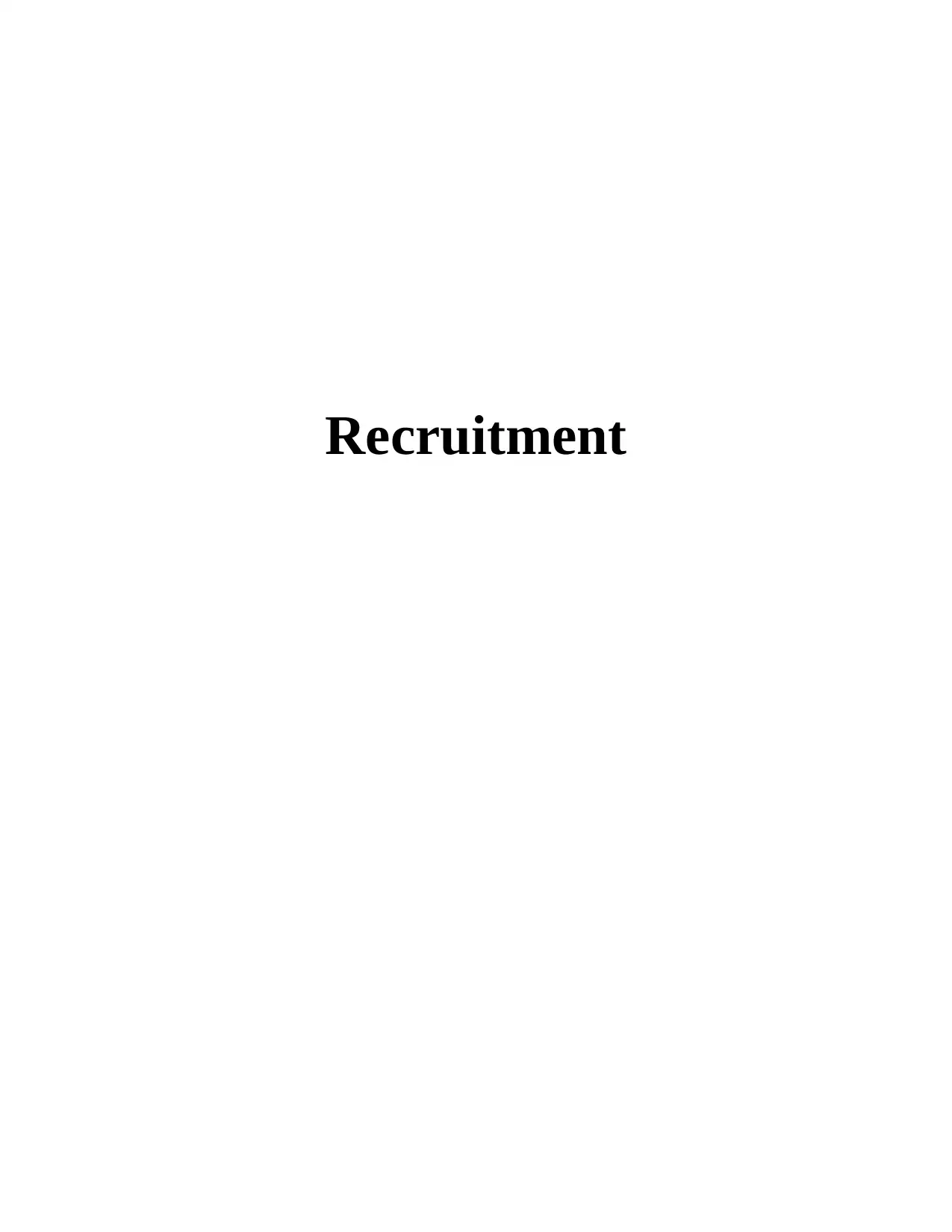
Recruitment
Paraphrase This Document
Need a fresh take? Get an instant paraphrase of this document with our AI Paraphraser
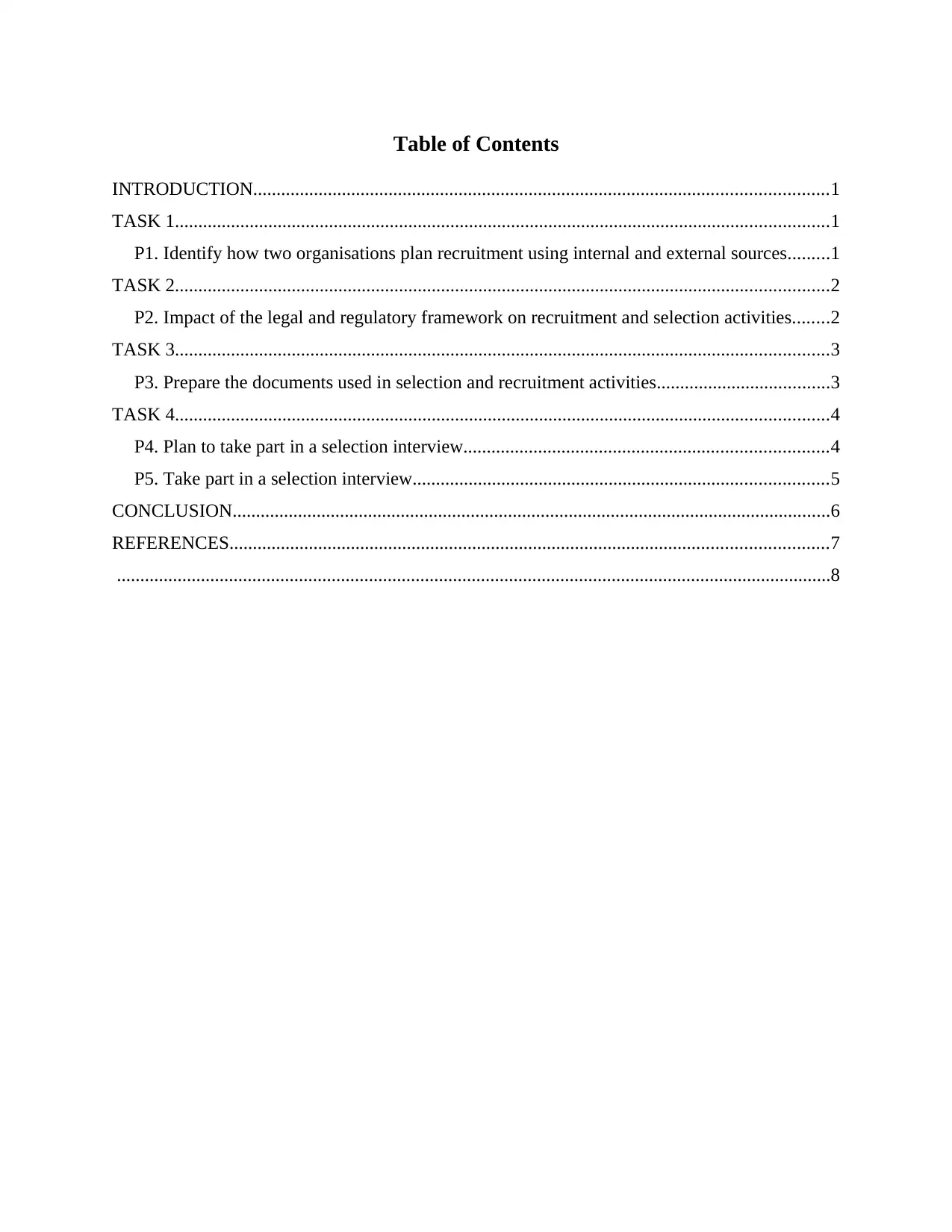
Table of Contents
INTRODUCTION...........................................................................................................................1
TASK 1............................................................................................................................................1
P1. Identify how two organisations plan recruitment using internal and external sources.........1
TASK 2............................................................................................................................................2
P2. Impact of the legal and regulatory framework on recruitment and selection activities........2
TASK 3............................................................................................................................................3
P3. Prepare the documents used in selection and recruitment activities.....................................3
TASK 4............................................................................................................................................4
P4. Plan to take part in a selection interview..............................................................................4
P5. Take part in a selection interview.........................................................................................5
CONCLUSION................................................................................................................................6
REFERENCES................................................................................................................................7
.........................................................................................................................................................8
INTRODUCTION...........................................................................................................................1
TASK 1............................................................................................................................................1
P1. Identify how two organisations plan recruitment using internal and external sources.........1
TASK 2............................................................................................................................................2
P2. Impact of the legal and regulatory framework on recruitment and selection activities........2
TASK 3............................................................................................................................................3
P3. Prepare the documents used in selection and recruitment activities.....................................3
TASK 4............................................................................................................................................4
P4. Plan to take part in a selection interview..............................................................................4
P5. Take part in a selection interview.........................................................................................5
CONCLUSION................................................................................................................................6
REFERENCES................................................................................................................................7
.........................................................................................................................................................8

⊘ This is a preview!⊘
Do you want full access?
Subscribe today to unlock all pages.

Trusted by 1+ million students worldwide
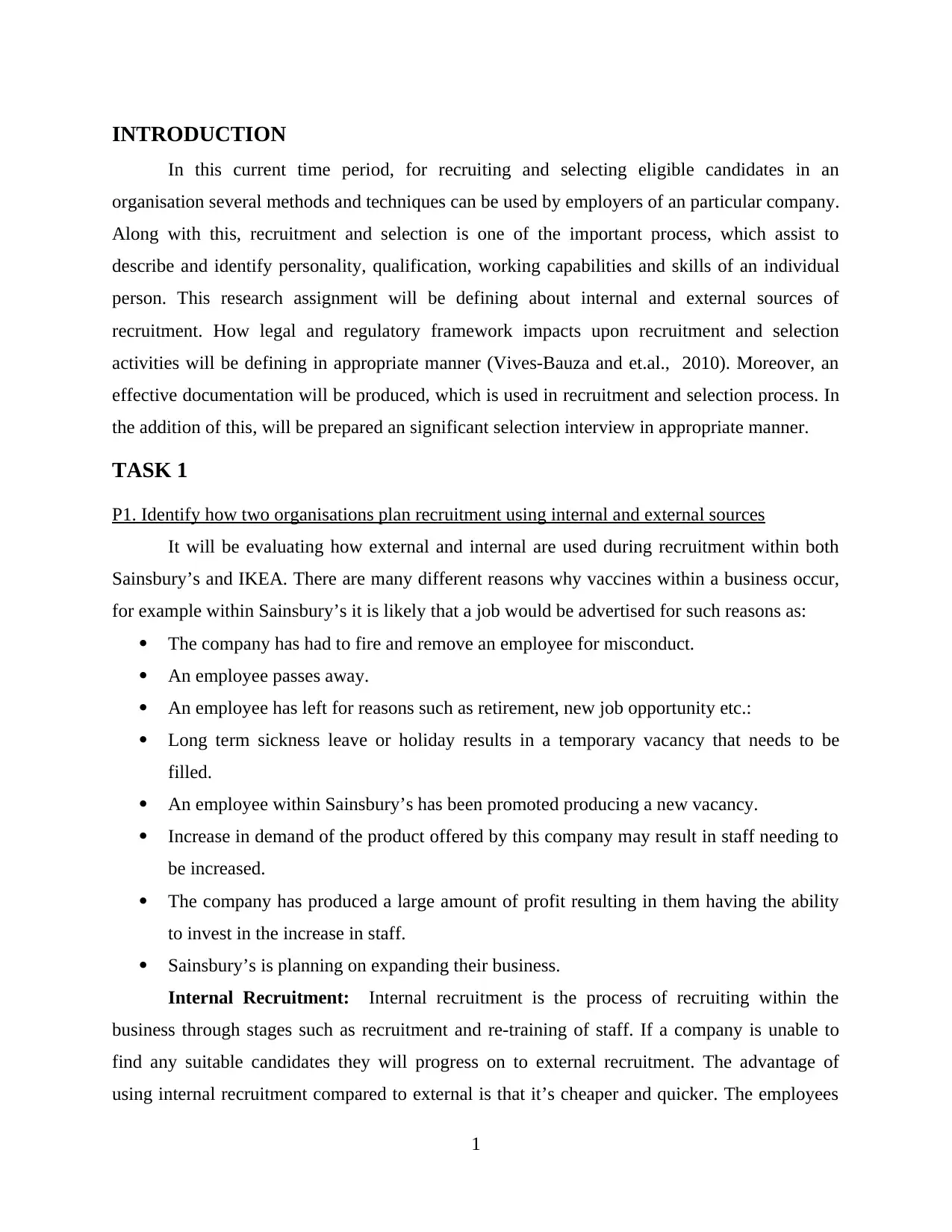
INTRODUCTION
In this current time period, for recruiting and selecting eligible candidates in an
organisation several methods and techniques can be used by employers of an particular company.
Along with this, recruitment and selection is one of the important process, which assist to
describe and identify personality, qualification, working capabilities and skills of an individual
person. This research assignment will be defining about internal and external sources of
recruitment. How legal and regulatory framework impacts upon recruitment and selection
activities will be defining in appropriate manner (Vives-Bauza and et.al., 2010). Moreover, an
effective documentation will be produced, which is used in recruitment and selection process. In
the addition of this, will be prepared an significant selection interview in appropriate manner.
TASK 1
P1. Identify how two organisations plan recruitment using internal and external sources
It will be evaluating how external and internal are used during recruitment within both
Sainsbury’s and IKEA. There are many different reasons why vaccines within a business occur,
for example within Sainsbury’s it is likely that a job would be advertised for such reasons as:
The company has had to fire and remove an employee for misconduct.
An employee passes away.
An employee has left for reasons such as retirement, new job opportunity etc.:
Long term sickness leave or holiday results in a temporary vacancy that needs to be
filled.
An employee within Sainsbury’s has been promoted producing a new vacancy.
Increase in demand of the product offered by this company may result in staff needing to
be increased.
The company has produced a large amount of profit resulting in them having the ability
to invest in the increase in staff.
Sainsbury’s is planning on expanding their business.
Internal Recruitment: Internal recruitment is the process of recruiting within the
business through stages such as recruitment and re-training of staff. If a company is unable to
find any suitable candidates they will progress on to external recruitment. The advantage of
using internal recruitment compared to external is that it’s cheaper and quicker. The employees
1
In this current time period, for recruiting and selecting eligible candidates in an
organisation several methods and techniques can be used by employers of an particular company.
Along with this, recruitment and selection is one of the important process, which assist to
describe and identify personality, qualification, working capabilities and skills of an individual
person. This research assignment will be defining about internal and external sources of
recruitment. How legal and regulatory framework impacts upon recruitment and selection
activities will be defining in appropriate manner (Vives-Bauza and et.al., 2010). Moreover, an
effective documentation will be produced, which is used in recruitment and selection process. In
the addition of this, will be prepared an significant selection interview in appropriate manner.
TASK 1
P1. Identify how two organisations plan recruitment using internal and external sources
It will be evaluating how external and internal are used during recruitment within both
Sainsbury’s and IKEA. There are many different reasons why vaccines within a business occur,
for example within Sainsbury’s it is likely that a job would be advertised for such reasons as:
The company has had to fire and remove an employee for misconduct.
An employee passes away.
An employee has left for reasons such as retirement, new job opportunity etc.:
Long term sickness leave or holiday results in a temporary vacancy that needs to be
filled.
An employee within Sainsbury’s has been promoted producing a new vacancy.
Increase in demand of the product offered by this company may result in staff needing to
be increased.
The company has produced a large amount of profit resulting in them having the ability
to invest in the increase in staff.
Sainsbury’s is planning on expanding their business.
Internal Recruitment: Internal recruitment is the process of recruiting within the
business through stages such as recruitment and re-training of staff. If a company is unable to
find any suitable candidates they will progress on to external recruitment. The advantage of
using internal recruitment compared to external is that it’s cheaper and quicker. The employees
1
Paraphrase This Document
Need a fresh take? Get an instant paraphrase of this document with our AI Paraphraser
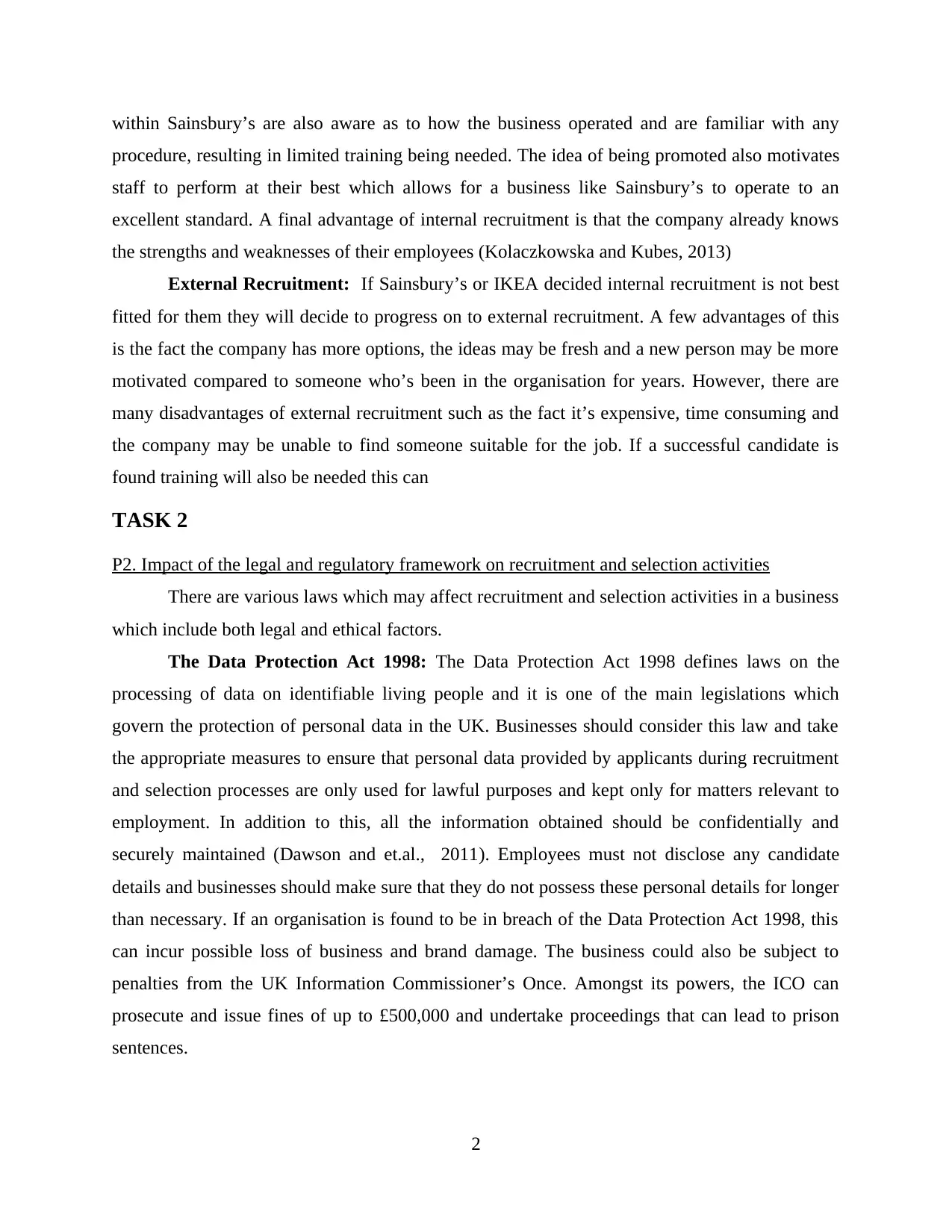
within Sainsbury’s are also aware as to how the business operated and are familiar with any
procedure, resulting in limited training being needed. The idea of being promoted also motivates
staff to perform at their best which allows for a business like Sainsbury’s to operate to an
excellent standard. A final advantage of internal recruitment is that the company already knows
the strengths and weaknesses of their employees (Kolaczkowska and Kubes, 2013)
External Recruitment: If Sainsbury’s or IKEA decided internal recruitment is not best
fitted for them they will decide to progress on to external recruitment. A few advantages of this
is the fact the company has more options, the ideas may be fresh and a new person may be more
motivated compared to someone who’s been in the organisation for years. However, there are
many disadvantages of external recruitment such as the fact it’s expensive, time consuming and
the company may be unable to find someone suitable for the job. If a successful candidate is
found training will also be needed this can
TASK 2
P2. Impact of the legal and regulatory framework on recruitment and selection activities
There are various laws which may affect recruitment and selection activities in a business
which include both legal and ethical factors.
The Data Protection Act 1998: The Data Protection Act 1998 defines laws on the
processing of data on identifiable living people and it is one of the main legislations which
govern the protection of personal data in the UK. Businesses should consider this law and take
the appropriate measures to ensure that personal data provided by applicants during recruitment
and selection processes are only used for lawful purposes and kept only for matters relevant to
employment. In addition to this, all the information obtained should be confidentially and
securely maintained (Dawson and et.al., 2011). Employees must not disclose any candidate
details and businesses should make sure that they do not possess these personal details for longer
than necessary. If an organisation is found to be in breach of the Data Protection Act 1998, this
can incur possible loss of business and brand damage. The business could also be subject to
penalties from the UK Information Commissioner’s Once. Amongst its powers, the ICO can
prosecute and issue fines of up to £500,000 and undertake proceedings that can lead to prison
sentences.
2
procedure, resulting in limited training being needed. The idea of being promoted also motivates
staff to perform at their best which allows for a business like Sainsbury’s to operate to an
excellent standard. A final advantage of internal recruitment is that the company already knows
the strengths and weaknesses of their employees (Kolaczkowska and Kubes, 2013)
External Recruitment: If Sainsbury’s or IKEA decided internal recruitment is not best
fitted for them they will decide to progress on to external recruitment. A few advantages of this
is the fact the company has more options, the ideas may be fresh and a new person may be more
motivated compared to someone who’s been in the organisation for years. However, there are
many disadvantages of external recruitment such as the fact it’s expensive, time consuming and
the company may be unable to find someone suitable for the job. If a successful candidate is
found training will also be needed this can
TASK 2
P2. Impact of the legal and regulatory framework on recruitment and selection activities
There are various laws which may affect recruitment and selection activities in a business
which include both legal and ethical factors.
The Data Protection Act 1998: The Data Protection Act 1998 defines laws on the
processing of data on identifiable living people and it is one of the main legislations which
govern the protection of personal data in the UK. Businesses should consider this law and take
the appropriate measures to ensure that personal data provided by applicants during recruitment
and selection processes are only used for lawful purposes and kept only for matters relevant to
employment. In addition to this, all the information obtained should be confidentially and
securely maintained (Dawson and et.al., 2011). Employees must not disclose any candidate
details and businesses should make sure that they do not possess these personal details for longer
than necessary. If an organisation is found to be in breach of the Data Protection Act 1998, this
can incur possible loss of business and brand damage. The business could also be subject to
penalties from the UK Information Commissioner’s Once. Amongst its powers, the ICO can
prosecute and issue fines of up to £500,000 and undertake proceedings that can lead to prison
sentences.
2
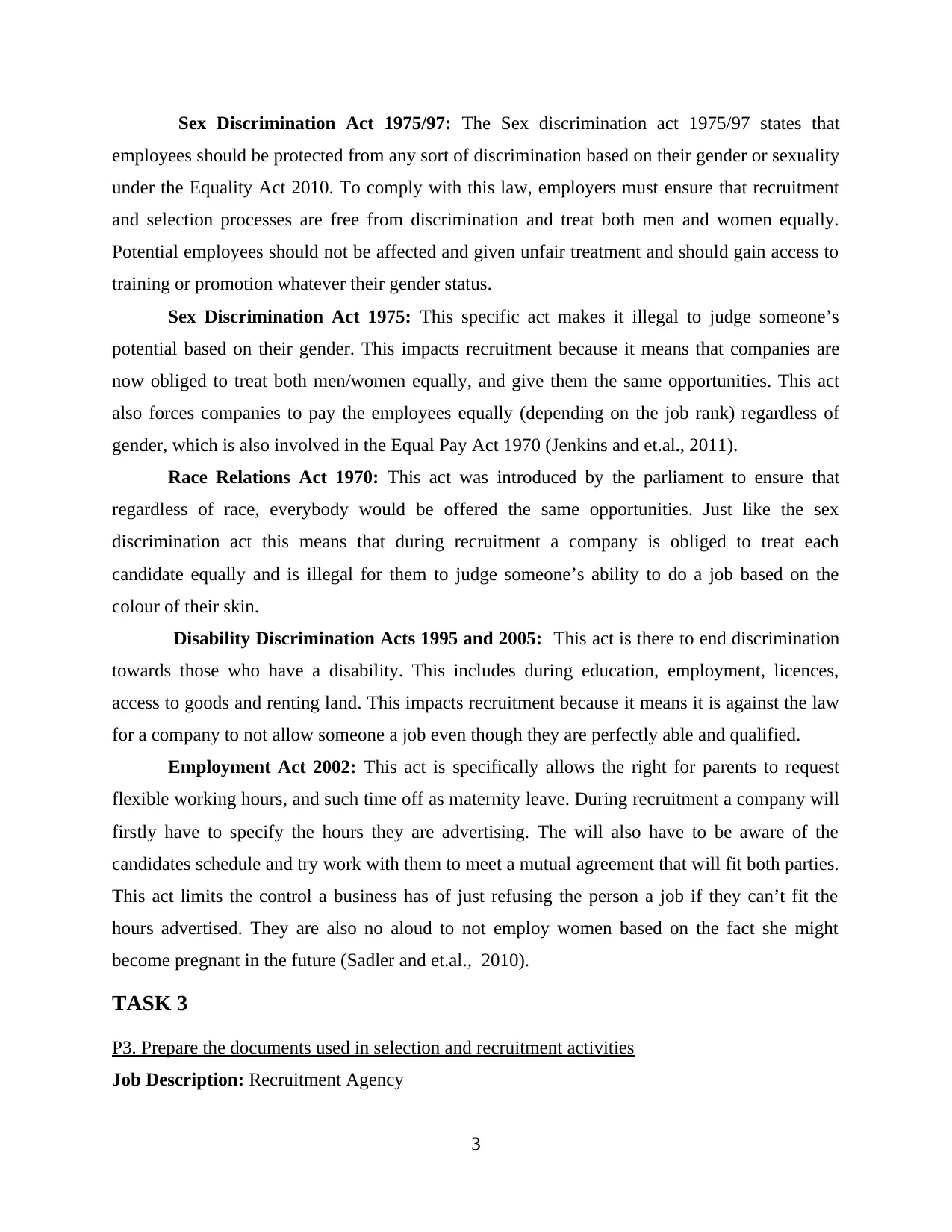
Sex Discrimination Act 1975/97: The Sex discrimination act 1975/97 states that
employees should be protected from any sort of discrimination based on their gender or sexuality
under the Equality Act 2010. To comply with this law, employers must ensure that recruitment
and selection processes are free from discrimination and treat both men and women equally.
Potential employees should not be affected and given unfair treatment and should gain access to
training or promotion whatever their gender status.
Sex Discrimination Act 1975: This specific act makes it illegal to judge someone’s
potential based on their gender. This impacts recruitment because it means that companies are
now obliged to treat both men/women equally, and give them the same opportunities. This act
also forces companies to pay the employees equally (depending on the job rank) regardless of
gender, which is also involved in the Equal Pay Act 1970 (Jenkins and et.al., 2011).
Race Relations Act 1970: This act was introduced by the parliament to ensure that
regardless of race, everybody would be offered the same opportunities. Just like the sex
discrimination act this means that during recruitment a company is obliged to treat each
candidate equally and is illegal for them to judge someone’s ability to do a job based on the
colour of their skin.
Disability Discrimination Acts 1995 and 2005: This act is there to end discrimination
towards those who have a disability. This includes during education, employment, licences,
access to goods and renting land. This impacts recruitment because it means it is against the law
for a company to not allow someone a job even though they are perfectly able and qualified.
Employment Act 2002: This act is specifically allows the right for parents to request
flexible working hours, and such time off as maternity leave. During recruitment a company will
firstly have to specify the hours they are advertising. The will also have to be aware of the
candidates schedule and try work with them to meet a mutual agreement that will fit both parties.
This act limits the control a business has of just refusing the person a job if they can’t fit the
hours advertised. They are also no aloud to not employ women based on the fact she might
become pregnant in the future (Sadler and et.al., 2010).
TASK 3
P3. Prepare the documents used in selection and recruitment activities
Job Description: Recruitment Agency
3
employees should be protected from any sort of discrimination based on their gender or sexuality
under the Equality Act 2010. To comply with this law, employers must ensure that recruitment
and selection processes are free from discrimination and treat both men and women equally.
Potential employees should not be affected and given unfair treatment and should gain access to
training or promotion whatever their gender status.
Sex Discrimination Act 1975: This specific act makes it illegal to judge someone’s
potential based on their gender. This impacts recruitment because it means that companies are
now obliged to treat both men/women equally, and give them the same opportunities. This act
also forces companies to pay the employees equally (depending on the job rank) regardless of
gender, which is also involved in the Equal Pay Act 1970 (Jenkins and et.al., 2011).
Race Relations Act 1970: This act was introduced by the parliament to ensure that
regardless of race, everybody would be offered the same opportunities. Just like the sex
discrimination act this means that during recruitment a company is obliged to treat each
candidate equally and is illegal for them to judge someone’s ability to do a job based on the
colour of their skin.
Disability Discrimination Acts 1995 and 2005: This act is there to end discrimination
towards those who have a disability. This includes during education, employment, licences,
access to goods and renting land. This impacts recruitment because it means it is against the law
for a company to not allow someone a job even though they are perfectly able and qualified.
Employment Act 2002: This act is specifically allows the right for parents to request
flexible working hours, and such time off as maternity leave. During recruitment a company will
firstly have to specify the hours they are advertising. The will also have to be aware of the
candidates schedule and try work with them to meet a mutual agreement that will fit both parties.
This act limits the control a business has of just refusing the person a job if they can’t fit the
hours advertised. They are also no aloud to not employ women based on the fact she might
become pregnant in the future (Sadler and et.al., 2010).
TASK 3
P3. Prepare the documents used in selection and recruitment activities
Job Description: Recruitment Agency
3
⊘ This is a preview!⊘
Do you want full access?
Subscribe today to unlock all pages.

Trusted by 1+ million students worldwide
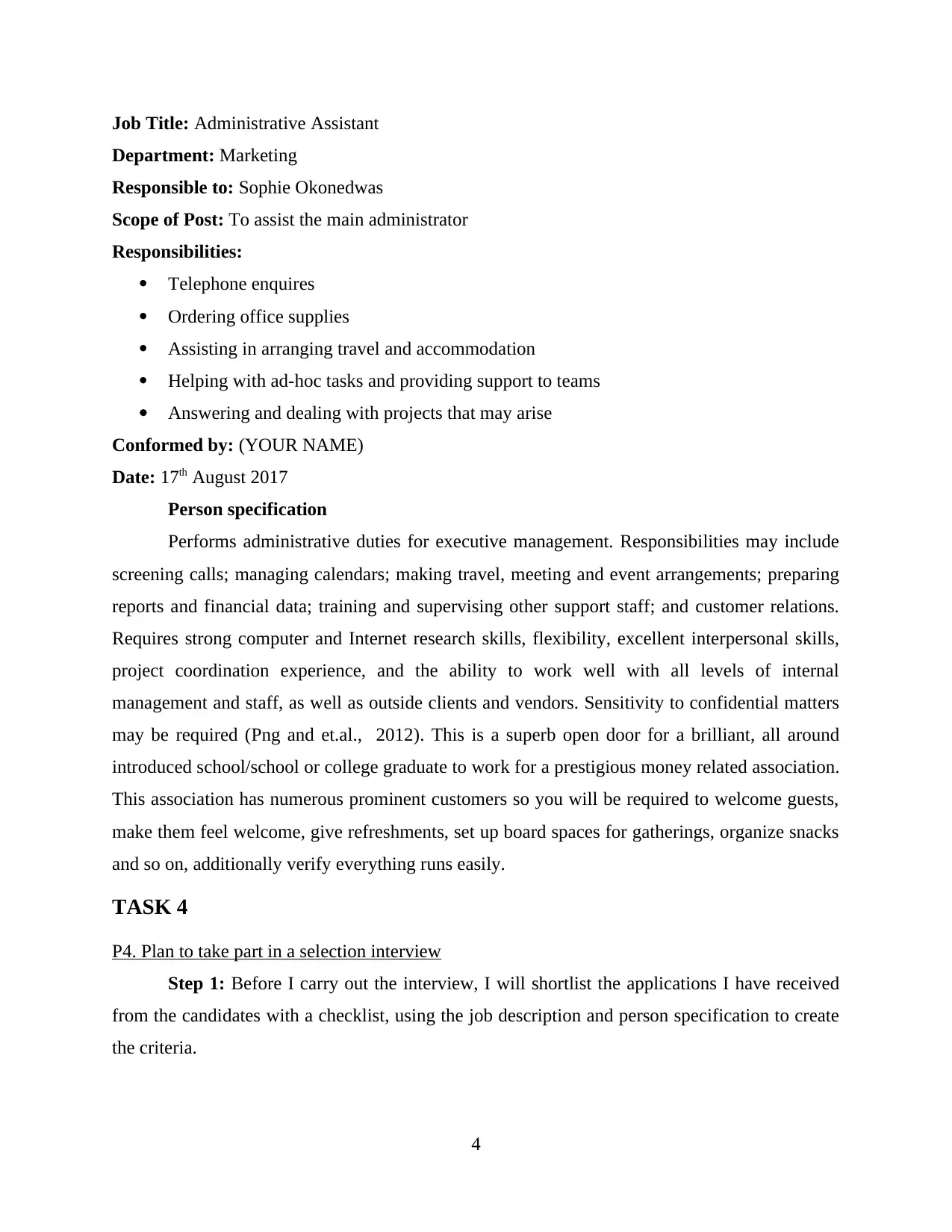
Job Title: Administrative Assistant
Department: Marketing
Responsible to: Sophie Okonedwas
Scope of Post: To assist the main administrator
Responsibilities:
Telephone enquires
Ordering office supplies
Assisting in arranging travel and accommodation
Helping with ad-hoc tasks and providing support to teams
Answering and dealing with projects that may arise
Conformed by: (YOUR NAME)
Date: 17th August 2017
Person specification
Performs administrative duties for executive management. Responsibilities may include
screening calls; managing calendars; making travel, meeting and event arrangements; preparing
reports and financial data; training and supervising other support staff; and customer relations.
Requires strong computer and Internet research skills, flexibility, excellent interpersonal skills,
project coordination experience, and the ability to work well with all levels of internal
management and staff, as well as outside clients and vendors. Sensitivity to confidential matters
may be required (Png and et.al., 2012). This is a superb open door for a brilliant, all around
introduced school/school or college graduate to work for a prestigious money related association.
This association has numerous prominent customers so you will be required to welcome guests,
make them feel welcome, give refreshments, set up board spaces for gatherings, organize snacks
and so on, additionally verify everything runs easily.
TASK 4
P4. Plan to take part in a selection interview
Step 1: Before I carry out the interview, I will shortlist the applications I have received
from the candidates with a checklist, using the job description and person specification to create
the criteria.
4
Department: Marketing
Responsible to: Sophie Okonedwas
Scope of Post: To assist the main administrator
Responsibilities:
Telephone enquires
Ordering office supplies
Assisting in arranging travel and accommodation
Helping with ad-hoc tasks and providing support to teams
Answering and dealing with projects that may arise
Conformed by: (YOUR NAME)
Date: 17th August 2017
Person specification
Performs administrative duties for executive management. Responsibilities may include
screening calls; managing calendars; making travel, meeting and event arrangements; preparing
reports and financial data; training and supervising other support staff; and customer relations.
Requires strong computer and Internet research skills, flexibility, excellent interpersonal skills,
project coordination experience, and the ability to work well with all levels of internal
management and staff, as well as outside clients and vendors. Sensitivity to confidential matters
may be required (Png and et.al., 2012). This is a superb open door for a brilliant, all around
introduced school/school or college graduate to work for a prestigious money related association.
This association has numerous prominent customers so you will be required to welcome guests,
make them feel welcome, give refreshments, set up board spaces for gatherings, organize snacks
and so on, additionally verify everything runs easily.
TASK 4
P4. Plan to take part in a selection interview
Step 1: Before I carry out the interview, I will shortlist the applications I have received
from the candidates with a checklist, using the job description and person specification to create
the criteria.
4
Paraphrase This Document
Need a fresh take? Get an instant paraphrase of this document with our AI Paraphraser
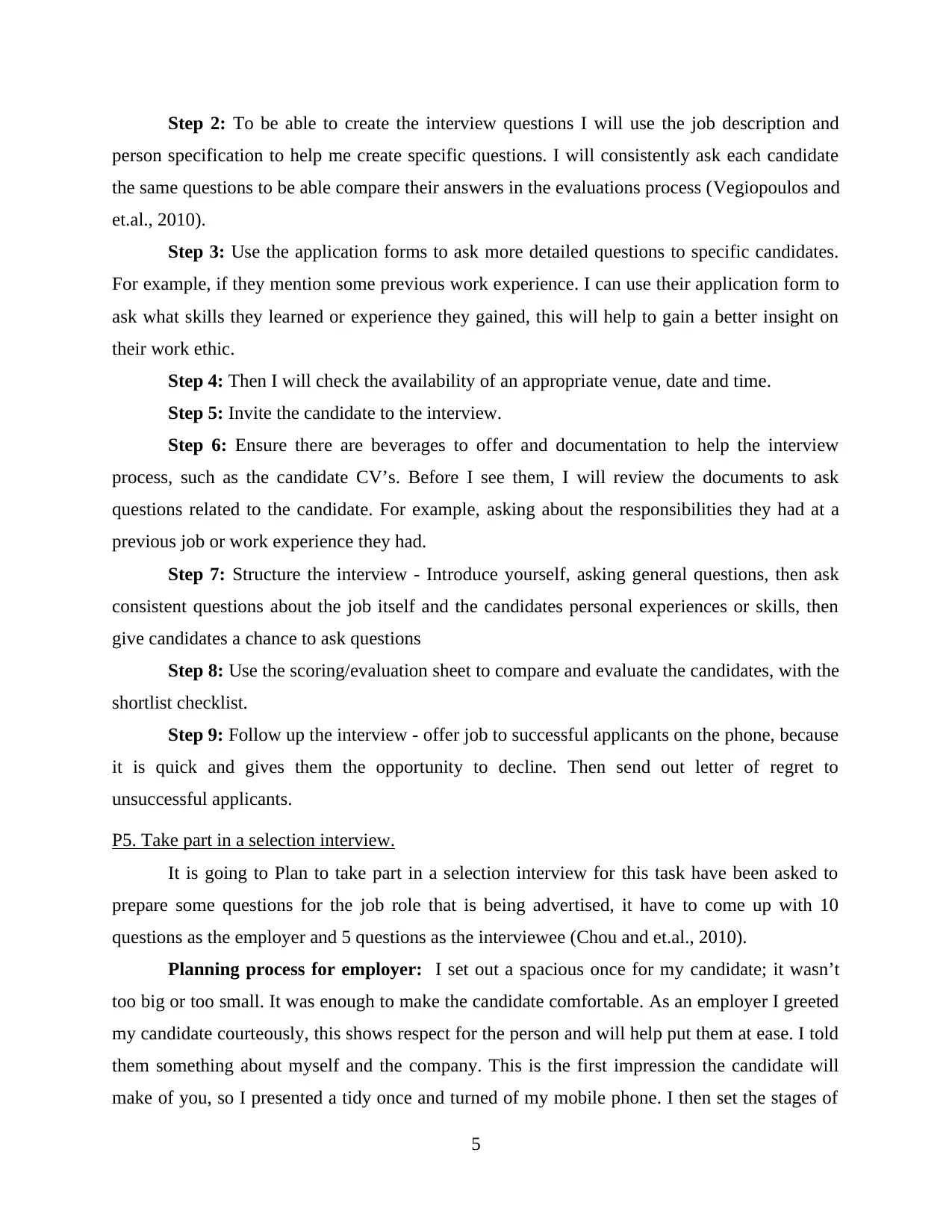
Step 2: To be able to create the interview questions I will use the job description and
person specification to help me create specific questions. I will consistently ask each candidate
the same questions to be able compare their answers in the evaluations process (Vegiopoulos and
et.al., 2010).
Step 3: Use the application forms to ask more detailed questions to specific candidates.
For example, if they mention some previous work experience. I can use their application form to
ask what skills they learned or experience they gained, this will help to gain a better insight on
their work ethic.
Step 4: Then I will check the availability of an appropriate venue, date and time.
Step 5: Invite the candidate to the interview.
Step 6: Ensure there are beverages to offer and documentation to help the interview
process, such as the candidate CV’s. Before I see them, I will review the documents to ask
questions related to the candidate. For example, asking about the responsibilities they had at a
previous job or work experience they had.
Step 7: Structure the interview - Introduce yourself, asking general questions, then ask
consistent questions about the job itself and the candidates personal experiences or skills, then
give candidates a chance to ask questions
Step 8: Use the scoring/evaluation sheet to compare and evaluate the candidates, with the
shortlist checklist.
Step 9: Follow up the interview - offer job to successful applicants on the phone, because
it is quick and gives them the opportunity to decline. Then send out letter of regret to
unsuccessful applicants.
P5. Take part in a selection interview.
It is going to Plan to take part in a selection interview for this task have been asked to
prepare some questions for the job role that is being advertised, it have to come up with 10
questions as the employer and 5 questions as the interviewee (Chou and et.al., 2010).
Planning process for employer: I set out a spacious once for my candidate; it wasn’t
too big or too small. It was enough to make the candidate comfortable. As an employer I greeted
my candidate courteously, this shows respect for the person and will help put them at ease. I told
them something about myself and the company. This is the first impression the candidate will
make of you, so I presented a tidy once and turned of my mobile phone. I then set the stages of
5
person specification to help me create specific questions. I will consistently ask each candidate
the same questions to be able compare their answers in the evaluations process (Vegiopoulos and
et.al., 2010).
Step 3: Use the application forms to ask more detailed questions to specific candidates.
For example, if they mention some previous work experience. I can use their application form to
ask what skills they learned or experience they gained, this will help to gain a better insight on
their work ethic.
Step 4: Then I will check the availability of an appropriate venue, date and time.
Step 5: Invite the candidate to the interview.
Step 6: Ensure there are beverages to offer and documentation to help the interview
process, such as the candidate CV’s. Before I see them, I will review the documents to ask
questions related to the candidate. For example, asking about the responsibilities they had at a
previous job or work experience they had.
Step 7: Structure the interview - Introduce yourself, asking general questions, then ask
consistent questions about the job itself and the candidates personal experiences or skills, then
give candidates a chance to ask questions
Step 8: Use the scoring/evaluation sheet to compare and evaluate the candidates, with the
shortlist checklist.
Step 9: Follow up the interview - offer job to successful applicants on the phone, because
it is quick and gives them the opportunity to decline. Then send out letter of regret to
unsuccessful applicants.
P5. Take part in a selection interview.
It is going to Plan to take part in a selection interview for this task have been asked to
prepare some questions for the job role that is being advertised, it have to come up with 10
questions as the employer and 5 questions as the interviewee (Chou and et.al., 2010).
Planning process for employer: I set out a spacious once for my candidate; it wasn’t
too big or too small. It was enough to make the candidate comfortable. As an employer I greeted
my candidate courteously, this shows respect for the person and will help put them at ease. I told
them something about myself and the company. This is the first impression the candidate will
make of you, so I presented a tidy once and turned of my mobile phone. I then set the stages of
5
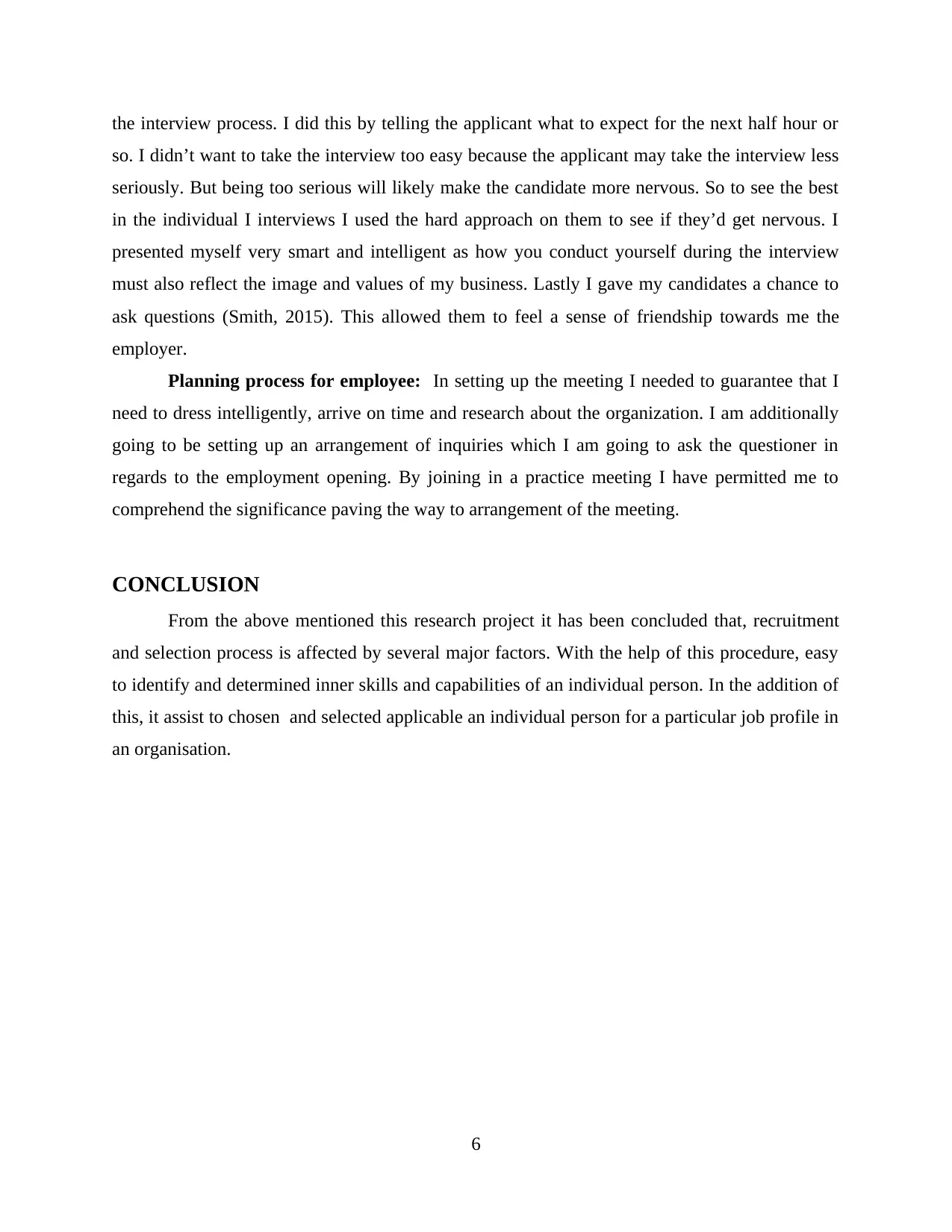
the interview process. I did this by telling the applicant what to expect for the next half hour or
so. I didn’t want to take the interview too easy because the applicant may take the interview less
seriously. But being too serious will likely make the candidate more nervous. So to see the best
in the individual I interviews I used the hard approach on them to see if they’d get nervous. I
presented myself very smart and intelligent as how you conduct yourself during the interview
must also reflect the image and values of my business. Lastly I gave my candidates a chance to
ask questions (Smith, 2015). This allowed them to feel a sense of friendship towards me the
employer.
Planning process for employee: In setting up the meeting I needed to guarantee that I
need to dress intelligently, arrive on time and research about the organization. I am additionally
going to be setting up an arrangement of inquiries which I am going to ask the questioner in
regards to the employment opening. By joining in a practice meeting I have permitted me to
comprehend the significance paving the way to arrangement of the meeting.
CONCLUSION
From the above mentioned this research project it has been concluded that, recruitment
and selection process is affected by several major factors. With the help of this procedure, easy
to identify and determined inner skills and capabilities of an individual person. In the addition of
this, it assist to chosen and selected applicable an individual person for a particular job profile in
an organisation.
6
so. I didn’t want to take the interview too easy because the applicant may take the interview less
seriously. But being too serious will likely make the candidate more nervous. So to see the best
in the individual I interviews I used the hard approach on them to see if they’d get nervous. I
presented myself very smart and intelligent as how you conduct yourself during the interview
must also reflect the image and values of my business. Lastly I gave my candidates a chance to
ask questions (Smith, 2015). This allowed them to feel a sense of friendship towards me the
employer.
Planning process for employee: In setting up the meeting I needed to guarantee that I
need to dress intelligently, arrive on time and research about the organization. I am additionally
going to be setting up an arrangement of inquiries which I am going to ask the questioner in
regards to the employment opening. By joining in a practice meeting I have permitted me to
comprehend the significance paving the way to arrangement of the meeting.
CONCLUSION
From the above mentioned this research project it has been concluded that, recruitment
and selection process is affected by several major factors. With the help of this procedure, easy
to identify and determined inner skills and capabilities of an individual person. In the addition of
this, it assist to chosen and selected applicable an individual person for a particular job profile in
an organisation.
6
⊘ This is a preview!⊘
Do you want full access?
Subscribe today to unlock all pages.

Trusted by 1+ million students worldwide
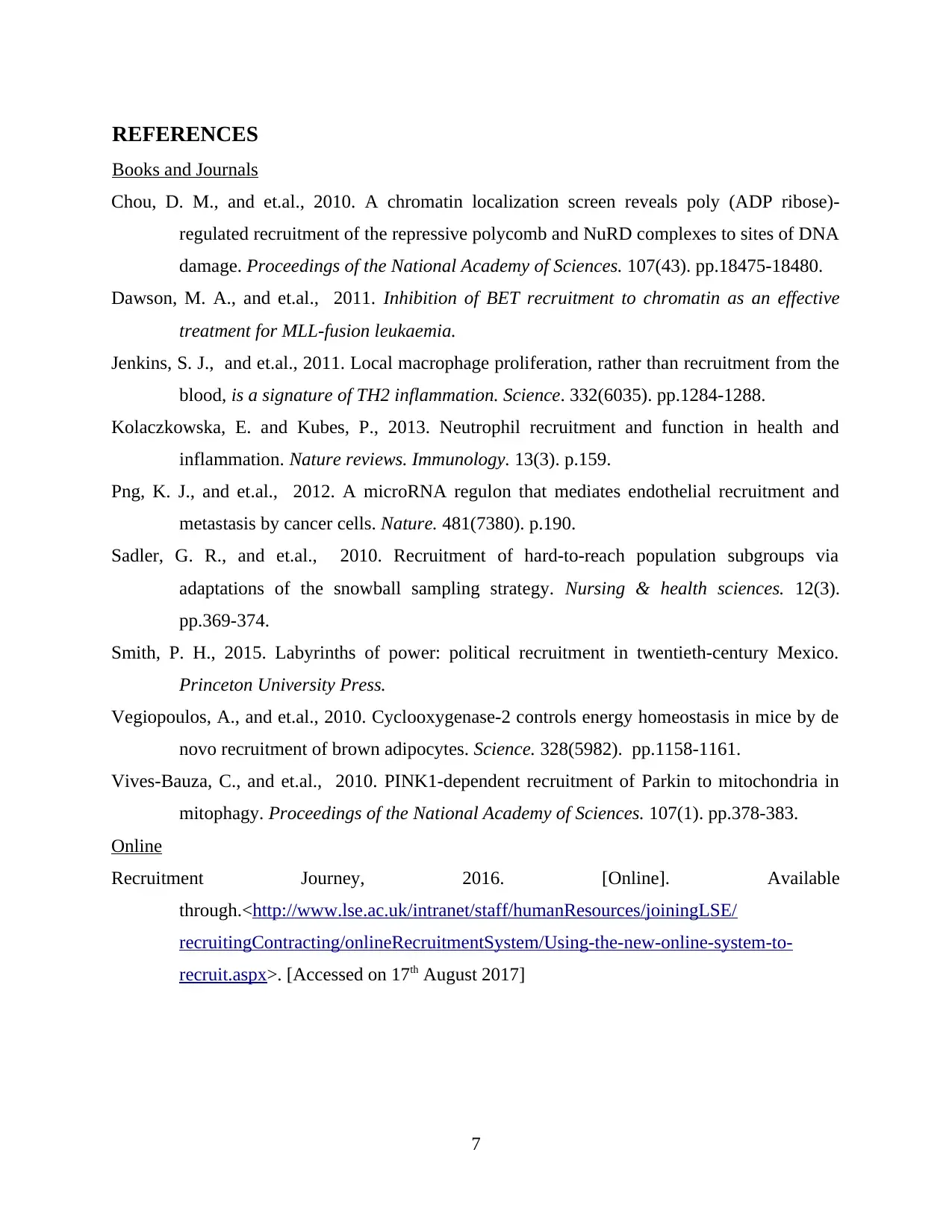
REFERENCES
Books and Journals
Chou, D. M., and et.al., 2010. A chromatin localization screen reveals poly (ADP ribose)-
regulated recruitment of the repressive polycomb and NuRD complexes to sites of DNA
damage. Proceedings of the National Academy of Sciences. 107(43). pp.18475-18480.
Dawson, M. A., and et.al., 2011. Inhibition of BET recruitment to chromatin as an effective
treatment for MLL-fusion leukaemia.
Jenkins, S. J., and et.al., 2011. Local macrophage proliferation, rather than recruitment from the
blood, is a signature of TH2 inflammation. Science. 332(6035). pp.1284-1288.
Kolaczkowska, E. and Kubes, P., 2013. Neutrophil recruitment and function in health and
inflammation. Nature reviews. Immunology. 13(3). p.159.
Png, K. J., and et.al., 2012. A microRNA regulon that mediates endothelial recruitment and
metastasis by cancer cells. Nature. 481(7380). p.190.
Sadler, G. R., and et.al., 2010. Recruitment of hard‐to‐reach population subgroups via
adaptations of the snowball sampling strategy. Nursing & health sciences. 12(3).
pp.369-374.
Smith, P. H., 2015. Labyrinths of power: political recruitment in twentieth-century Mexico.
Princeton University Press.
Vegiopoulos, A., and et.al., 2010. Cyclooxygenase-2 controls energy homeostasis in mice by de
novo recruitment of brown adipocytes. Science. 328(5982). pp.1158-1161.
Vives-Bauza, C., and et.al., 2010. PINK1-dependent recruitment of Parkin to mitochondria in
mitophagy. Proceedings of the National Academy of Sciences. 107(1). pp.378-383.
Online
Recruitment Journey, 2016. [Online]. Available
through.<http://www.lse.ac.uk/intranet/staff/humanResources/joiningLSE/
recruitingContracting/onlineRecruitmentSystem/Using-the-new-online-system-to-
recruit.aspx>. [Accessed on 17th August 2017]
7
Books and Journals
Chou, D. M., and et.al., 2010. A chromatin localization screen reveals poly (ADP ribose)-
regulated recruitment of the repressive polycomb and NuRD complexes to sites of DNA
damage. Proceedings of the National Academy of Sciences. 107(43). pp.18475-18480.
Dawson, M. A., and et.al., 2011. Inhibition of BET recruitment to chromatin as an effective
treatment for MLL-fusion leukaemia.
Jenkins, S. J., and et.al., 2011. Local macrophage proliferation, rather than recruitment from the
blood, is a signature of TH2 inflammation. Science. 332(6035). pp.1284-1288.
Kolaczkowska, E. and Kubes, P., 2013. Neutrophil recruitment and function in health and
inflammation. Nature reviews. Immunology. 13(3). p.159.
Png, K. J., and et.al., 2012. A microRNA regulon that mediates endothelial recruitment and
metastasis by cancer cells. Nature. 481(7380). p.190.
Sadler, G. R., and et.al., 2010. Recruitment of hard‐to‐reach population subgroups via
adaptations of the snowball sampling strategy. Nursing & health sciences. 12(3).
pp.369-374.
Smith, P. H., 2015. Labyrinths of power: political recruitment in twentieth-century Mexico.
Princeton University Press.
Vegiopoulos, A., and et.al., 2010. Cyclooxygenase-2 controls energy homeostasis in mice by de
novo recruitment of brown adipocytes. Science. 328(5982). pp.1158-1161.
Vives-Bauza, C., and et.al., 2010. PINK1-dependent recruitment of Parkin to mitochondria in
mitophagy. Proceedings of the National Academy of Sciences. 107(1). pp.378-383.
Online
Recruitment Journey, 2016. [Online]. Available
through.<http://www.lse.ac.uk/intranet/staff/humanResources/joiningLSE/
recruitingContracting/onlineRecruitmentSystem/Using-the-new-online-system-to-
recruit.aspx>. [Accessed on 17th August 2017]
7
Paraphrase This Document
Need a fresh take? Get an instant paraphrase of this document with our AI Paraphraser

8
1 out of 11
Related Documents
Your All-in-One AI-Powered Toolkit for Academic Success.
+13062052269
info@desklib.com
Available 24*7 on WhatsApp / Email
![[object Object]](/_next/static/media/star-bottom.7253800d.svg)
Unlock your academic potential
Copyright © 2020–2025 A2Z Services. All Rights Reserved. Developed and managed by ZUCOL.





